Joe Blevins's Blog, page 51
January 23, 2022
Ed Wood's When the Topic is Sex: "Origins of a Fur Fetishist" (1971)
 Wouldn't you like to run your fingers through this fur?
Wouldn't you like to run your fingers through this fur?
NOTE: This article continues my coverage of Ed Wood's When the Topic is Sex (BearManor Media, 2021).
The article: "Origins of a Fur Fetishist." Originally published in Ecstasy (Pendulum Publishing), vol. 3, no. 1, March/April 1971.
Excerpt: "The sights, sounds, smells and sensations of that day, as personally experienced by that little boy, were to stamp his character forever afterward. They were to become intertwined with some of Europe's greatest literature which seemed to be both history and fiction but which was actually heavily tainted by the deep-seated algolagnia of the author."
Reflections: Bob Blackburn compiled When the Topic is Sex the same way he put together the previous two Ed Wood collections, i.e. by following Eddie's own writing résumé. If a story or article appeared on that résumé, Bob did his best to track down the magazine in which it originally appeared. When Bob bought the March/April 1971 issue of Ecstasy, for example, he was probably looking for the short story "The Last Void," which eventually turned up in Angora Fever (2019).
But not all of Eddie's magazine work made it to his résumé. As my colleague Greg Dziawer has reminded us again and again, publisher Bernie Bloom had Ed writing all kinds of text for the Pendulum/Calga magazines, everything from photo captions to editorials. When Bob got his copy of Ecstasy, he discovered an uncredited article called "Origins of a Fur Fetishist" and concluded that it must've been Ed's. After all, Eddie was writing a lot of articles about fetishism back then, and fur fetishism was a particular specialty of Ed's since it was a kink that he himself possessed. Who else would have written something like this?
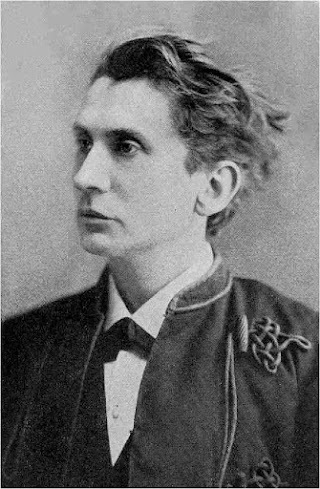 Leopold von Sacher-MasochIf it is indeed Eddie's work, "Origins of a Fur Fetishist" stands out as one of the more coherent, even elegant examples of his nonfiction articles. This one focuses entirely on a specific historical figure: Austrian writer Leopold von Sacher-Masoch (1836-1895). Now, Eddie has fixated on other real-life personages in his work, returning repeatedly to the lives of Albert Fish (1870-1936) and Elizabeth Báthory (1560-1614). Offhand, I couldn't remember Eddie writing more about Sacher-Masoch in any of his full-length books, although he does use the obscure term "algolagnia" (sexual pleasure derived from giving or receiving pain) in Bloodiest Sex Crimes of History (1967).
Leopold von Sacher-MasochIf it is indeed Eddie's work, "Origins of a Fur Fetishist" stands out as one of the more coherent, even elegant examples of his nonfiction articles. This one focuses entirely on a specific historical figure: Austrian writer Leopold von Sacher-Masoch (1836-1895). Now, Eddie has fixated on other real-life personages in his work, returning repeatedly to the lives of Albert Fish (1870-1936) and Elizabeth Báthory (1560-1614). Offhand, I couldn't remember Eddie writing more about Sacher-Masoch in any of his full-length books, although he does use the obscure term "algolagnia" (sexual pleasure derived from giving or receiving pain) in Bloodiest Sex Crimes of History (1967).Sacher-Masoch is primarily known for two things: writing the 1870 novella Venus in Furs and being the namesake of the term "masochism." So this nobleman obviously had fetishes for both fur and pain. How did he get that way? Well, it all goes back to his boyhood experiences with his aunt, the Countess Zenobia. The article describes her colorfully: "a statuesque and commanding woman in her middle thirties—a passionately demanding female who had never been sexually satisfied or emotionally controlled by her insignificant husband." She sounds like someone who was specifically created to be a character in an erotic story.
As a boy, Leopold loved to rummage through his aunt's wardrobe, fondling the furs and sniffing the nightgowns. (This is probably the most Wood-ian passage in the entire article.) Once, while doing this, he quickly had to hide in the closet as his aunt entertained a lover. Again, the description of the events is colorful: "When the strange man was on his back, the Countess Zenobia mounted him like a Valkyrie astride a magic horse and rode her steed in a violent gallop as though toward some mighty battle." Uh huh. Magic horse. Got it.
Anyway, the countess and her lover were themselves surprised mid-coitus by the "small, frail" count. Irritated at this distraction, Zenobia quickly took to smacking her husband around, all while young Leopold watched from the closet. The lover was so horrified that he immediately departed. Then, still nude, Zenobia discovered Leopold hiding in the closet and began spanking him. This entire incident is highly reminiscent of a memorable passage from David Lynch's kinky and violent Blue Velvet (1986), so much so that I have to wonder if Lynch deliberately referenced Sader-Masoch. Even the title of Lynch's film suggests a fetishistic fixation on a particular fabric.
You can see how this kind of incident might have an effect on a young man like our hapless Austrian friend. According to this article, though, Leopold's kinks were confined to his imagination and his writing. "Leopold von Sacher-Masoch was never a debauchee in sexual matters," the author assures us. Wouldn't that be a strange twist of fate, leading a vanilla sex life and having a famous kink named after you anyway? He never even contracted syphilis!
Earlier in this review, I described this article as "elegant." That quality really comes to the fore when, after having told the Countess Zenobia story, the author gives us a brief but vivid biological sketch of Leopold von Sacher-Masoch. A few chosen phrases, which I suggest you read aloud:The puzzle could not be complete for its construction carried on throughout his mature life and the image was always a mixture of his own dreams and the strange personal frustration the world and his selection of sexual partners thrust upon him.The brilliance, the wit and the dash of the past had been replaced by a certain melancholy that hung over Europe like a grey cloud.Those whispered bedtime stories told in hushed and mysterious tones that implied even more than they actually state were all Gothic tales of frenzied erotica and ruthless cruelty. Although illiterate, [Leopold's nurse] was undoubtedly a narrator of superlative talent for the tales she told formed a rich and macabre tapestry woven of all the sensuous and barbaric, tragic and wild elements latent in the tribal memory of a strangely primitive people.Both the syntax and vocabulary of these passages are highly unusual for Ed Wood. Perhaps, on the day this piece was composed, Eddie was in the mood to write something more elevated and poetic than usual. As I've said, he had a number of modes or styles as a writer and could switch between them when necessary.
I regret to say that "Origins of a Fur Fetishist" takes a strange and disturbing turn at the end. There is a passage involving very young children and the things that "ignorant and primitive" people have done to them in the past. Rather than describe this material further, I will let readers of When the Topic is Sex discover it for themselves. Forewarned is forearmed.
Next: "There Are Different Words" (1974)
Published on January 23, 2022 18:01
January 22, 2022
Ed Wood's When the Topic is Sex: "Witchcraft in America Today" (1971)
 Witches today can't hold a candle to the ones of the past.
Witches today can't hold a candle to the ones of the past.
NOTE: This article continues my coverage of Ed Wood's When the Topic is Sex (BearManor Media, 2021).
The article: "Witchcraft in America Today." Originally published in Lesbo Lassies (Calga Publishing), vol. 3, no. 2, April/May 1971.
Excerpt: "It can be seen from these Hippie witches that witchcraft is anything but dead in this country and has over recent years been undergoing quite a revival. Many of the modern-day witches, involved as they are in terrorist actions, would like to see nothing better than authority overthrown and destroyed."
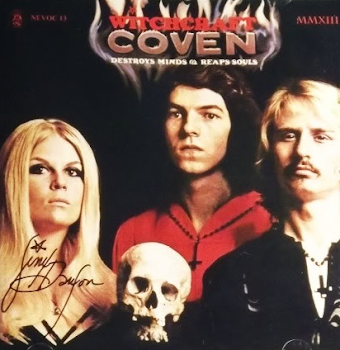 A 1969 album by the band Coven.Reflections: America's young people were definitely trying to find their own way in the late 1960s and early 1970s, rejecting the values of their square, uptight parents—whose actions had led to the Vietnam War, polluted cities, racial segregation, and the Nixon presidency—and trying to form a groovy new culture to call their own. There were many avenues for them to explore, including music, drugs, sex, fashion, hairstyles, art, and politics. Hippies famously got into all of those things, often combining them.
A 1969 album by the band Coven.Reflections: America's young people were definitely trying to find their own way in the late 1960s and early 1970s, rejecting the values of their square, uptight parents—whose actions had led to the Vietnam War, polluted cities, racial segregation, and the Nixon presidency—and trying to form a groovy new culture to call their own. There were many avenues for them to explore, including music, drugs, sex, fashion, hairstyles, art, and politics. Hippies famously got into all of those things, often combining them.But what of religion? Some youngsters aligned themselves with the evangelical "Jesus movement," anointing Christ as the ultimate hippie. The Son of Man was, after all, known for having long hair and a beard, wearing sandals, promoting peace, and rejecting capitalism. Others, however, weren't down with the J-man. They went in the exact opposite direction, embracing Satanism and witchcraft. I'm not sure how seriously they took it. The rock band Coven seemed fairly sincere in their beliefs, but Victor Luminera's film Psyched by the 4-D Witch (A Tale of Demonology) (1973) makes the whole "hippie witch" phenomenon look like a joke or a gimmick.
"Witchcraft in America Today" is Ed Wood's attempt to make some sense of the fad and explain it to others in his own demographic, i.e. horny middle-aged men who just want to know what kinky things the youngsters are doing these days. This is one of the articles in When the Topic is Sex for which Ed did no research. Not a single book or author is cited, though there is a fleeting reference to the then-recent Charles Manson trial. Ed feels, however, that it is important to make some distinctions when talking about this subculture: "While the Satanists use sex and drug to pervert and deprave, the Hippie witches use the same tools simply because they enjoy them and feel that they are the natural thing to do."
Ed's arguments are all over the place. At first, he suggests that the witchcraft revival comes from "the largely Negro areas of the big cities," but then he switches tactics and focuses on "hippie witches," who tend to be young, attractive, white females. Eddie suggests that a typical hippie witch will be "thrown into such fields as political and social reform" and is frequently seen "at the student demonstrations, using her skills to bring others over to her way of thinking." He even mentions a political organization called W.I.T.C.H., whose acronym stands for Women's International Terrorist Corps from Hell. I thought this was purely a product of Eddie's imagination, but there is evidence that W.I.T.C.H. was a real organization and staged protests against abortion laws "using street and guerilla theater."
Surprisingly, considering this article was written for a magazine called Lesbo Lassies, Ed downplays the sex angle in "Witchcraft in America Today." He doesn't ignore it, though. He simply states that modern hippie witches feel that sex is "a natural part of life" and therefore practice it without restrictions, guilt, or hangups. In this way, witchcraft may offer a refreshing alternative to Christianity. As Ed explains:
Certainly the evil interpretation of Satan has only come about as a result of Christianity and its doctrines. Because to the church, sex was a cardinal sin, therefore the sexual practices of the witches seemed like a monstrous blasphemy against God. In fact, the sex orgies that the church so condemned were basically nothing more or less than fertility rites, a joyous thanksgiving to nature for the gift of life and fertility.If that doesn't sell you on witchcraft as a lifestyle, nothing will.
Next: "Origins of a Fur Fetishist" (1971)
Published on January 22, 2022 09:19
January 21, 2022
Ed Wood's When the Topic is Sex: "Madam Had a Peep" (1972)
 She likes to watch.
She likes to watch.
NOTE: This article continues my coverage of Ed Wood's When the Topic is Sex (Bear Manor Media, 2021).
The article: "Madam Had a Peep." Originally published in Illustrated Case Histories: A Study of Voyeurism (Calga Publishing), vol. 2, no. 1, April/May 1971.
Excerpt: "I've never been caught and I don't expect to be. I'm actually not doing anything which could cause anybody any harm. And if they leave their window shades up, I suspect they want to be watched anyway . . . and there isn't any psychiatrist in the whole world who can tell me I'm some kind of a nut. I know a lot worse who do things that are monstrous. What's the harm in catching a little peep?"
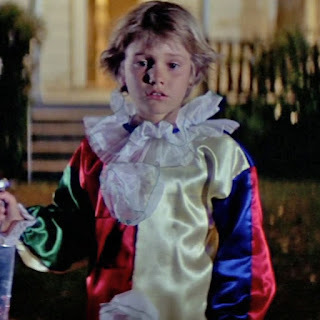 Michael Myers was another young voyeur.Reflections: "Madam Had a Peep" combines two of Ed Wood's longtime obsessions: (1) voyeurism and (2) women taking on traditionally male roles. We've all heard of Peeping Toms, but what about Peeping Thelmas? Yes, Ed Wood tells us, it may very well be a woman looking through the keyhole at the local motel. Doesn't that blow your mind? A new frontier for sexual equality!
Michael Myers was another young voyeur.Reflections: "Madam Had a Peep" combines two of Ed Wood's longtime obsessions: (1) voyeurism and (2) women taking on traditionally male roles. We've all heard of Peeping Toms, but what about Peeping Thelmas? Yes, Ed Wood tells us, it may very well be a woman looking through the keyhole at the local motel. Doesn't that blow your mind? A new frontier for sexual equality!In this article, Ed pretends to interview one such peeper, a fictional young woman identified only as Tammney M. I don't mind Eddie's pseudo-interviews, but I wish that—just once—he had staggered out of his apartment long enough to talk to a real person, one whose speech cadences aren't exactly the same as his own and whose anecdotes are based on real-world experiences.
Anyway, Tammney fills us in on how and why she does what she does. You see, her first sexual experience was with the school bully. "I wanted my first one to be big and tough," she explains. The whole ordeal was so unpleasant that she vowed forever after to be a watcher rather than a doer. She started by watching her sister and her boyfriend make love in the living room. Come to think of it, that's exactly how Michael Myers started in John Carpenter's original Halloween (1978).
Now, as a "nearly thirty" adult, Tammney likes to pick out a secluded spot and watch couples having sex—gay, straight, lesbian, it's all good. She gratifies herself through masturbation, either "out in the field" or in a "completely dark room." Her low-budget sex toys include hairbrushes and douche nozzles. She points out that she does not use a mirror during this process, however. That makes her stand out from many of Ed Wood's other characters. I have not written enough about how important mirrors are in many of Ed's short stories, novels, and articles. Suffice it to say, a full-length mirror was nearly as important to him as an angora sweater.
"Madam Had a Peep" is a surprisingly sympathetic portrait of a female voyeur. Tammney points out that she's avoiding sexually-transmitted diseases as well as unwanted pregnancies. Ed does have a warning for Tammney: "Diseases come just as easily from a finger, a hair brush and a douche handle if one hasn't prepared a sanitary flush." So keep peeping, America. Just play it safe.
Next: "Witchcraft in America Today" (1971)
Published on January 21, 2022 16:15
January 20, 2022
Ed Wood's When the Topic is Sex: "A Thought on Fetish Love Objects" (1972)
 Today, Ed Wood has something on his mind.
Today, Ed Wood has something on his mind.
NOTE: This article continues my coverage of Ed Wood's When the Topic is Sex (BearManor Media, 2021).
The article: "A Thought on Fetish Love Objects." Originally published in Young Beavers (Pendulum Publishing), vol. 6, no. 1, March/April 1972. No author credited.
Excerpt: "Fetish love-objects are as varied as the mind might conceive. Some say the hair fetish comes from the thought that Christ was crucified while wearing a hair shirt . . . thus a double meaning . . . hair and religious values."
Reflections: The term "love-object" is used so frequently in When the Topic is Sex that I can't believe I hadn't noticed it as one of Ed Wood's trademarks earlier than this. It definitely belongs on the list. And now, Eddie has devoted an entire article to it. You might guess that a "love-object" is a dildo, vibrator, or some other marital aid, but that's not necessarily what Eddie means. In the context of this article and others, it's any inanimate, non-living object that arouses sexual feelings in a person. Here, he focuses specifically on clothing and hair.
As you might guess, Eddie's take on hair fetishism is a little warped. He says that a woman with long, flowing hair might wrap her luscious locks around her lover's genitals or even use "the hair upon her own body for her own pleasures." Not being a hair fetishist myself, I can't really say whether this is how it works or not. He also describes a young husband driven to violent rage when his wife gets a short haircut.
Actually, a more accurate title for this article would be "A Handful of Half-Baked Ideas Vaguely Related to Love Objects." For some reason, Eddie spends several paragraphs talking about how newlyweds reveal their fetishes to one another. It doesn't always go well, as Ed illustrates with this example:
There was the story in one of the syndicated columns of a major newspaper recently about the newlyweds who got to their hotel room, stripped, then when the girl was about to put on her wedding nightie the new husband took it from her and put it on himself. Shocked, the girl screamed down the building and the fellow raced out of the room never to be heard of again . . . except in the divorce courts.Anyone halfway familiar with Ed Wood's own biography will be immediately reminded of the director's disastrous, short-lived marriage to actress Norma McCarty, who couldn't abide Eddie's cross-dressing. Brief as it was, the Wood/McCarty marriage led to some of the more memorable anecdotes in Rudolph Grey's Nightmare of Ecstasy (1992).
 Kathy Wood and Paul Marco discuss Ed's marriage to Norma McCarty.
Kathy Wood and Paul Marco discuss Ed's marriage to Norma McCarty.These stories were dramatized for Tim Burton's film Ed Wood (1994), but unfortunately they landed on the cutting room floor.
As with other articles in When the Topic is Sex, "A Thought on Fetish Love Objects" cites several works by other authors. First up is The American Dictionary of Sexual Terms (1964) by Blake Roger. According to Blake, armpits are a "classic" fetish. Go figure. This glossary-style book is very real and easily found today on the secondary market. Eddie concludes his own book, Bloodiest Sex Crimes of History (1967), with what he terms "the hottest sex glossary ever compiled." (Ed's list even includes the little-used "ecouterism") I wonder if he cribbed much from Blake Roger?
Even more interesting, Ed mentions an article by Sylvia Lazio called "Queer for Hair" from the January 10, 1971 issue of The National Bulletin. I can't pinpoint this exact article, but The National Bulletin was a sex-themed tabloid published in the early 1970s by a New Rochelle, NY-based company called Beta. It combined nude cheesecake photos with salacious articles like "Perverts Make the Best Athletes" and "Is America Losing the Sex Race?"
Ed Wood also mentions an article by Buzz Torin in The National Spotlite . This was another Beta publication—same format as Bulletin, very similar content. It cannot be a coincidence that Eddie would mention two Beta tabloids in the same article. Maybe, as someone working in the adult magazine industry, Ed Wood kept, uh, abreast of what the competition was doing. But you'd think that Bernie Bloom would insist that Eddie plug other Pendulum/Calga titles instead!
Next: "Madam Had a Peep" (1971)
Published on January 20, 2022 17:14
Ed Wood's When the Topic is Sex: "Sorcery and Sex" (1970)
 The greatest combination since peanut butter and jelly.
The greatest combination since peanut butter and jelly.
NOTE: This article continues my coverage of Ed Wood's When the Topic is Sex (BearManor Media, 2021).
The article: "Sorcery and Sex." Originally published in Wild Couples (Pendulum Publishing), vol. 1, no. 2, February/March 1970. No author credited. Also known as "Sex and Sorcery."
Excerpt: "During the Communion, we partake symbolically of the Master's flesh and blood. The transubstantiation bit, you know? The liquid is prepared according to rigid specifications. Seven parts semen, one part blood, one part urine. And the donor has to be a practicing warlock. Our donor tonight had to shoot his load five times to fill the chalice. It left him looking a bit peaked, too."
Reflections: I think Eddie would have very much enjoyed Stanley Kubrick's final film, Eyes Wide Shut (1999), had he lived to see it. Hell, he'd probably have wanted to make the low-budget knockoff version for the home video market. The centerpiece of that film is a mysterious ritual—held in a mansion and attended by the wealthy and powerful—that combines sex with elements of Catholicism and various pagan religions. Although carried out with a great deal of pomp and ceremony, this ritual is essentially an orgy.
At first, I thought "Sorcery and Sex" was a short story about just such a sex ritual and wondered what this piece was doing in When the Topic is Sex alongside Ed Wood's supposed nonfiction articles. As I read further, however, I realized that this article was being presented as a bit of investigative journalism. The premise is that Ed, apparently acting on behalf of Wild Couples magazine, has been allowed to attend a black mass and later interview the high priestess, Cybele, about what it all means. (It turns out she's really a housewife named Melissa, by the way.) There's a lot of history behind this so-called "Black Mass," and the priestess mentions the Druids, Stonehenge, Zoroastrianism, and Faust during her interview.
Ed's naturally a bit squeamish about the strange ritual—especially the parts where the celebrants spit on a cross and drink semen from a chalice—but he's simply allowed to observe. "I learned later that visitors are exempted from the dark rituals," he explains. Whew! That's a relief, huh? In a weird way, this article also reminded me of the Universal horror film Cult of the Cobra (1955) in which a group of thrill-seeking American servicemen sneak into a meeting of a strange, snake-worshipping cult and witness much more than they bargained for. While that film is nowhere near as explicit as Eyes Wide Shut, the cult ritual does have an element of sex, particularly an erotic, snake-themed dance routine. For 1955, it's pretty hot stuff.
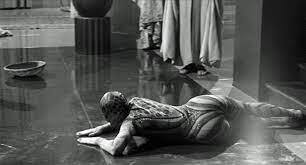 An erotic dance routine from Cult of the Cobra (1955).
An erotic dance routine from Cult of the Cobra (1955).Pagan sex rituals are fairly common in the Ed Wood canon. Again, we need only look to films like Orgy of the Dead (1965) and Necromania (1971) for similar scenes. The 1972 short story "The Witches of Amau Ra" is another variation on this theme. Ed really gets into the pageantry of it all, the chanting and the props, like inverted crosses. Who knows? Maybe the ritual described in this article—Cybele balks at the term "orgy"—would have been a typical Tuesday night at Anton LaVey's house circa 1970.
For me, the point at which this article makes the great leap into absurdity is when our intrepid reporter starts interviewing the high priestess. He lets us know that Cybele's robe is hanging open, giving him a good look at her anatomy. Then, after reciting a couple of incantations (written at about the intellectual level of dirty limericks), Cybele causes the reporter to have what he calls "the most incredible, mind-bending orgasm I have ever had in my life." At this point, "Sorcery and Sex" has essentially become a ghoulish Penthouse letter.
By the way, this is at least the second article in When the Topic is Sex to mention tooth loss. In "Use That Four Letter Word," Ed writes that the wrong choice of vocabulary might result in getting your teeth knocked out. And in this story, Cybele brags, "People learned not to annoy me or they might find their teeth falling out the next day." Obviously, Ed Wood was missing many of his own teeth by the time he wrote this story. If you want to know how he lost those teeth, read The Unknown War of Edward D. Wood, Jr. (2017) by James Pontolillo.
Next: "A Thought on Fetish Love Objects" (1972)
Published on January 20, 2022 05:06
January 18, 2022
Ed Wood's When the Topic is Sex: "Necrophilia: The Love of the Dead" (1973)
 A lovely logo for a not-very-lovely topic.
A lovely logo for a not-very-lovely topic.
NOTE: This article continues my coverage of Ed Wood's When the Topic is Sex (BearManor Media, 2021).
The article: "Necrophilia: The Love of the Dead." Originally published in Party Time (Gallery Press), vol. 2, no. 1, February/March 1973. Credited to "Dick Trent."
Excerpt: "Necrophilia can be a gruesome study. Variations in how the necrophiliac derives pleasure does much to increase the macabre circumstances. Most necrophiliacs take a more passive attitude and are content to simply commit intercourse, cunnilingus or onanism (masturbate) with the cadaver, or at least in the presence of the cadaver. Others are not content unless they also hack the body to pieces."
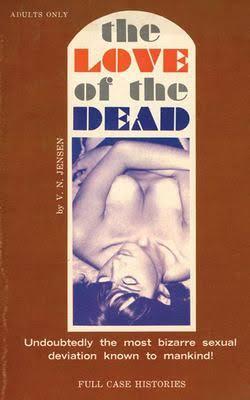 Eddie's graphic book about the topic.Reflections: How far are you willing to go in your pursuit of Edward D. Wood, Jr.? It's a question I've asked before, but I think it bears repeating today. Some fans stick to his better-known movies from the 1950s, preferring his more mainstream sci-fi/horror efforts such as Bride of the Monster (1955) and Plan 9 from Outer Space (1957). Others are willing to go a little further and explore Ed's adult film work from the '60s and '70s, just as long as the movies aren't too explicit or raunchy.
Eddie's graphic book about the topic.Reflections: How far are you willing to go in your pursuit of Edward D. Wood, Jr.? It's a question I've asked before, but I think it bears repeating today. Some fans stick to his better-known movies from the 1950s, preferring his more mainstream sci-fi/horror efforts such as Bride of the Monster (1955) and Plan 9 from Outer Space (1957). Others are willing to go a little further and explore Ed's adult film work from the '60s and '70s, just as long as the movies aren't too explicit or raunchy. I'd say, however, that the ultimate loyalty test for any Ed Wood fan is his writing—the novels, magazine articles, and nonfiction books Eddie penned during his darkest, drunkest years. Not only is most of this material pornographic in nature, often explicitly so, it's also Ed's most extreme in terms of subject matter. On the page, even more than on the screen, Ed Wood explored the dark side of sex. This includes detailed descriptions of various kinks, fetishes, and even violent crimes. It's understandable that some fans will not want to expose themselves to this kind of material.
No matter what your cutoff point for Ed Wood is, however, you've definitely seen evidence of Ed's career-long obsession with necrophilia, i.e. an erotic fixation on corpses. It's at the heart of Plan 9 from Outer Space, after all. It's woven throughout Orgy of the Dead (1965) and Necromania (1971), too. But, again, it's in his writing that Ed really runs wild with this topic. Under the pseudonym "V.N. Jensen," he wrote an entire, quite graphic book about necrophilia: The Love of the Dead (1968). He also discussed this unseemly topic in his other pseudo-educational paperbacks like Suburbia Confidential (1967) and Bloodiest Sex Crimes of History (1967).
The 1973 article "Necrophilia: The Love of the Dead" is in this same, disturbing vein—story after story of those who defile corpses for sexual pleasure and gratification. You'll notice the similarity to the title of his 1968 book. Eddie also manages to work in a plug for Necromania while he's at it. (This is one of the strangest examples of cross-promotion in showbiz history.) He does not hold back when it comes to gruesome, unpleasant details. One of the victims described in this article, for instance, is a three-year-old girl. Another dies after having a "sharp stake" thrust "into her rectum and vagina." The necrophiles in this story engage in all sorts of disgusting acts, including drinking urine and ejaculating on dead bodies. Some are also cannibals.
Bob Blackburn, who compiled When the Topic is Sex, warned me about this article in advance:
The necrophilia article is/was to me the most challenging of all 80 in the book. I think you and folks who've read it or will read it will understand. Of course it's totally in Ed's bailiwick. When I was re-reading it for the final edit/proofreading, I was kinda shocked at the graphicness of it. But, hey, it's pure Ed Wood.When he said that, I knew I had to revisit Ed's Love of the Dead book. When I read it a few months ago, I was steamrolling my way through as many of Ed's written works as possible, one after another in a short span of time. Under those circumstances, it didn't seem all that different from many of Ed's other adult paperbacks of the era—maybe a little kinkier, but not too outrageous.
Returning to the book now, though, I was taken aback by the way Ed truly wallows (what other word is there?) in the stomach-churning details of these violent sex crimes. Given how often he revisits the topic throughout his career, I have to wonder what was happening in Ed Wood's mind. I mean, who thinks about necrophilia that much? Bob is right that this is "Ed's bailiwick," but what a weird goddamned bailiwick it is. The saving grace of an article like this is its brevity. Sure, it's an unpleasant topic, but it's over after a few pages. If you can survive "Necrophilia: The Love of the Dead," you can handle just about anything Ed writes.
Ed tries to lend some credence to this article by quoting a few experts. One is Dr. James McCary, presumably the same one who wrote Sexual Myths and Fallacies (1971) . Another is Austrian psychologist Wilhelm Stekel (1868-1940), a disciple of Sigmund Freud. (Freud himself is not mentioned in this article but is namechecked in the Love of the Dead book.) As for the "Dr. Zugmund Siegel" who relates the story of a female necrophile who claims to have been impregnated by her dead husband, I can't find any evidence that he ever existed.
Next: "Sorcery and Sex" (1970)
Published on January 18, 2022 19:14
January 17, 2022
Ed Wood's When the Topic is Sex: "Use That Four Letter Word" (1971)
 A charming cartoon credited to someone named Dial accompanies this article.
A charming cartoon credited to someone named Dial accompanies this article.
NOTE: This article continues my coverage of Ed Wood's When the Topic is Sex (BearManor Media, 2021).
The article: "Use That Four Letter Word." Originally published in One Plus One (Pendulum Publishing), vol. 3, no. 3, September/October 1971. No author credited.
Excerpt: "Words always have taken on different connotations in the way they are said and in many cases who says them. When it comes to sexual implications this becomes all too important. Most of us in our life time have seen one man greet another with, 'Why you old son of a bitch,' and they walk away happily laughing and slapping each other on the back. But at another time and said in another tone somebody is going to be laying flat on their back with a swollen lip or nose and perhaps be missing a few teeth."
Reflections: You might have a guess as to what this article is about, based on its title. It's Ed Wood's position paper on profanity, right? Eh, sort of. Despite its title, "Use That Four Letter Word" is surprisingly light on profanity. It's more about the significance that supposedly "dirty" words have in the sex lives of certain people. And then, this being an Ed Wood article, it wanders off into other territory.
 Cartoonist Mort Walker coined the term "grawlix."First and foremost, this is a vocabulary lesson. Ed wants us to learn three specific terms: coprolaliac, ecouterist, and erotographomaniac. My spellchecker only recognizes the first of these. Meanwhile, "erotographomaniac" is a fairly well-recognized term, but I could only find "ecouterist" in a very small handful of books and articles. Google kept thinking I meant "ecotourist," i.e. one who travels for environmental reasons.
Cartoonist Mort Walker coined the term "grawlix."First and foremost, this is a vocabulary lesson. Ed wants us to learn three specific terms: coprolaliac, ecouterist, and erotographomaniac. My spellchecker only recognizes the first of these. Meanwhile, "erotographomaniac" is a fairly well-recognized term, but I could only find "ecouterist" in a very small handful of books and articles. Google kept thinking I meant "ecotourist," i.e. one who travels for environmental reasons.Basically, a coprolaliac is someone who likes saying dirty words, an ecouterist is someone who likes hearing dirty words, and an erotographomaniac is someone who likes writing dirty words (or drawing dirty pictures) in public places like restrooms. Obviously, coprolaliac and ecouterists can help each other out immensely, much like sadists and masochists, while the erotographomaniacs of the world are on their own. In this third group, Eddie also includes those who like taking polaroid pictures of their lovers. "He must necessarily have the pictures," Ed states, "or he will remain turned off."
Eddie informs us that homosexuals are into saying and hearing dirty words, but only when they're having sex with "rough trade," i.e. straight male prostitutes who are strictly "gay for pay." But talking is a big part of the sexual experience for just about everyone, the article insists. "Even animals have been known to howl their delights at those times."
To me, the most interesting part of the article is when Ed Wood proposes an end to profanity—not by banning any words but by removing their stigma.
It is interesting, however, to think that coprolalia is one of the deviations which could be immediately stamped out throughout the world in the matter of a few seconds. All we would have to do is take the curse from all words, make them freely usable, put them in the dictionary and never again hold any taboo against them. For this all existing taboos on any kind of language must be removed.I've often felt that the very concept of profanity is silly and counterproductive, verging on superstitious. Why should certain words—mere vowels and consonants, morphemes and phonemes—have any power over us? We're the ones in charge, after all, not the words. And yet, many people I know are greatly offended by profanities, and it's made me think more carefully about how I speak and write. I'll still use profanities, but I judge when and where to do so. Sometimes, depending on the audience you're addressing, using a "dirty" word may not be worth the trouble.
Next: "Necrophilia: The Love of the Dead" (1973)
Published on January 17, 2022 17:09
January 16, 2022
Ed Wood's When the Topic is Sex: "Indecent Exposure" (1971)
 This gentleman is probably just getting some sun.
This gentleman is probably just getting some sun.
NOTE: This article continues my coverage of Ed Wood's When the Topic is Sex (BearManor Media, 1971).
The article: "Indecent Exposure." Originally published in Garter Girls (Pendulum Publishing), vol. 5, no. 2, June/July 1971.
Excerpt: "As has been stated, this type of person does not get his sexual thrills through physical contact. It might be supposed the only way one might be hurt would be through an accident, such as the woman starting to scream too soon, and the exhibitionist attempting to halt that scream in order to give himself time to get away."
Reflections: In "Indecent Exposure," Ed Wood turns his attention to the flasher—that sexually-frustrated gentleman who gets his "kicks" by opening his overcoat and revealing his nudity to some unsuspecting woman. "No matter what the punishment which might be dealt out," Ed tells us, "little will deter these men from making their rounds and accomplishing their sexual purpose."
Admittedly, though flashers must really exist in this sick world of ours, my knowledge of them comes almost exclusively from pop culture, namely movies, sitcoms, and comedy sketches. On the 1970s soap opera parody Mary Hartman, Mary Hartman, for instance, the title character's grandfather (Victor Kilian) was revealed to be the town flasher. In John Waters' Pink Flamingos (1972), the villainous Raymond Marble (David Lochary) flashes some young women in the park, then steals their purses when they run away. And the comedy troupe Monty Python did a few bits about flashers, like this scene from their 1971 movie And Now for Something Completely Different.
Come to think of it, all those examples are from the 1970s, as is this Ed Wood article. Maybe the flasher had his day in the sun, so to speak, during that particular decade. Anyway, "Indecent Exposure" is Ed's attempt at understanding the exhibitionist—how and why he does what he does. Basically, it's all about sexual inadequacy. These men are too riddled with self-doubt to pursue consensual sexual relationships, so they choose instead to expose their genitals to women, just to prove that those genitals still exist and are (theoretically) functional.
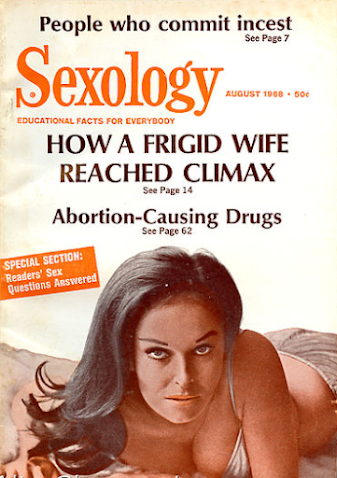 An issue of Sexology featuring Vernon W. Grant.Ed Wood being Ed Wood, he cannot stay on one topic for an entire article. His mind inevitably wanders. About two-thirds of the way through "Indecent Exposure," Eddie starts talking about voyeurs (or peeping toms) instead. His logic is that the voyeur is the opposite of the exhibitionist. One needs to see, while the other needs to be seen. While the sadist and the masochist need each other, however, no such symbiotic relationship exists between the voyeur and the exhibitionist. As Eddie puts it: "The voyeur can very well go about this peeping without having any of the exhibitionist qualities."
An issue of Sexology featuring Vernon W. Grant.Ed Wood being Ed Wood, he cannot stay on one topic for an entire article. His mind inevitably wanders. About two-thirds of the way through "Indecent Exposure," Eddie starts talking about voyeurs (or peeping toms) instead. His logic is that the voyeur is the opposite of the exhibitionist. One needs to see, while the other needs to be seen. While the sadist and the masochist need each other, however, no such symbiotic relationship exists between the voyeur and the exhibitionist. As Eddie puts it: "The voyeur can very well go about this peeping without having any of the exhibitionist qualities."Then, Eddie really goes far afield and starts talking about swingers and wife-swappers. What this has to do with anything, let alone flashers, is beyond me. Ed certainly doesn't make the connection clear, though the following passage sounds like it could have been taken directly from the script of The Young Marrieds (1972):
Sex being the motivating force of the Universe, man will have his affairs no matter what deviation might be involved. Thus many psychiatrists and sexologists and other medical and mental minds agree that these weekend groupings have a certain amount of therapy. However, since the swingers have only come out in the open during the recent few years these therapy pros and cons are still very much in the study stages. The men of letters, of course, have known about wife and husband swapping (former classic titles for the group sex and swinger affairs) for a great number of years.It means almost nothing, but it has the cadence of a scholarly dissertation.
"Indecent Exposure" is another article in which Ed Wood quotes from a real-life sexologist rather than relying strictly on his own imagination and memory. In this case, the quoted expert is one Vernon W. Grant, Ph.D., and the material being cited comes from Sexology magazine. As it happens, Sexology was a real magazine that ran for fifty years (1933-1983), and Grant really did write for them in the 1960s. He also penned such books as The Psychology of Sexual Emotion (1957), This is Mental Illness: How it Feels and What it Means (1970), The Roots of Religious Doubt and the Search for Security (1974). and The Menacing Stranger: A Primer on Psychopathy (1977).
Next: "Use that Four Letter Word" (1971)
Published on January 16, 2022 09:31
January 15, 2022
Ed Wood's When the Topic is Sex: "Problems and the Sex Change" (1972)
 This is like a cubist version of the Glen or Glenda poster artwork.
This is like a cubist version of the Glen or Glenda poster artwork.
NOTE: This article continues my coverage of Ed Wood's When the Topic is Sex (BearManor Media, 2021).
The article: "Problems and the Sex Change." Originally published in Ecstasy (Pendulum Publishing), vol. 4, no. 1, February/March 1972.
Excerpt: "The male nose has always been more prominent than most females. Therefore the transsexual who wishes to have the complete features of the female will also find that plastic surgery to the proboscis is all important. The ears follow a close second. The male has always had larger and stronger looking ears. We find that in nearly all of the transsexuals, no matter how effeminate he might be the ears are a stand out along with the Adams apple."
Reflections: In Tim Burton's Ed Wood (1994), there's a scene in which producer George Weiss (Mike Starr) complains to Eddie (Johnny Depp) that the much-touted sex change operation in Glen or Glenda only occurs "five pages before it ends." He adds, huffily: "The rest is about some schmuck who likes angora sweaters!" Ed's weak rejoinder: "I don't think he's a schmuck!"
I've never actually seen the Glen or Glenda screenplay, so I can't do an exact page count. By my calculations, however, the sequence involving Alan/Ann ("Tommy" Haynes), the male-to-female transsexual, occurs about 80% of the way through the movie. This is significant, since Glen or Glenda's entire reason for existing was to cash in on the Christine Jorgensen sex change story. Audiences had to wait for nearly an hour to get to this part of the film.
When this sequence finally arrives, it focuses with grim intensity on the ordeal that Alan went through to become Ann. Dr. Alton (Timothy Farrell) tells us about the emotional agony Alan suffered as a child, shunned by both his classmates and his own father (Captain DeZita). Once Alan was drafted, he had to hide his cross-dressing from his fellow soldiers. Eventually, he learned about sex change operations and decided to have one himself. But this is no easy way out, as Dr. Alton explains:
During the following two years, he was to go through the tortures of the damned, but never was there a whimper from him because he knew that at the end of it all, he would at last be that which he had always dreamed. Hundreds of hormone shots were injected into various parts of his body. Alan's face was worked on with plastic surgery to smooth out the female elements... long, tedious hours of work. The big day... or the starting of many big days, for it was to take many. The series of operations are performed, slowly and at intervals, to prevent any unnecessary shock to the nervous system. Still, the hormone shots continue... day after day, week after week, month after month, and even then, when the operation is over, the sex is changed, the shots must continue as long as Alan lives.And that's just the medical part of it! Ann had to learn how to do her own makeup and hair. She also had to learn "the duty of a woman in her sex life." It sounds grueling, but Dr. Alton insists that Ann "loved every minute of it." Okay, doc, if you say so.
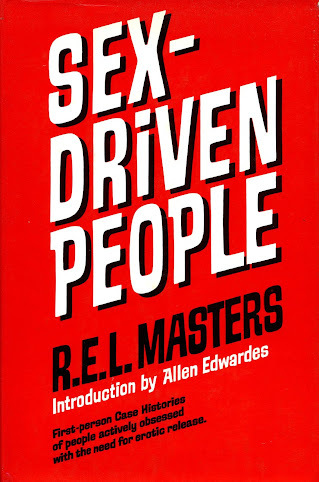 Reading material for Ed Wood.Ed Wood's 1972 article "Problems and the Sex Change" is very much in this same vein. Twenty years had elapsed since George William Jorgensen, Jr. became Christine Jorgensen, but male-to-female transsexuals still faced a series of medical, emotional, societal, and even legal hurdles. Eddie wants us to know—really wants us to know—that it's not all "peaches and cream" for the Christines of the world.
Reading material for Ed Wood.Ed Wood's 1972 article "Problems and the Sex Change" is very much in this same vein. Twenty years had elapsed since George William Jorgensen, Jr. became Christine Jorgensen, but male-to-female transsexuals still faced a series of medical, emotional, societal, and even legal hurdles. Eddie wants us to know—really wants us to know—that it's not all "peaches and cream" for the Christines of the world. In this story, Ed revisits many of the same tribulations he'd mentioned in Glen or Glenda, including those hormone injections and the need for plastic surgery, but he adds a few more. Silicone, for instance, may cause cancer. Surgically-constructed vaginas may grow together "which would mean another very painful operation." Then, there is the legal hassle of being recognized by the government as a female. Even once you get past all those hurdles, there is the possibility that orgasms will either be nonexistent or extremely uncomfortable. Ed further alleges that transsexuals are not supportive of one another. "So many are jealous of their sisters under the knife ever becoming their equal," he writes. Doesn't exactly make you want to run to your surgeon, does it?
Throughout "Problems and the Sex Change," Eddie repeatedly cites the 1966 book Sex-Driven People by R.E.L. Masters . I was not familiar with this book or its author, so I knew I had to find out more. As it turns out, Robert E.L. Masters (1927-2008) was a prolific sexologist of the 1960s and 1970s whose books include The Homosexual Revolution (1962), Patterns of Incest (1963), Sexual Self-Stimulation (1967), and Eros and Evil: The Sexual Psychopathology of Witchcraft (1974). He is not to be confused with gynecologist William H. Masters (1915-2001), though both Masters were influences on Ed Wood.
Here's another obituary for Robert Masters. It doesn't mention Sex-Driven People specifically, but it does say he "published eight books in the field of sexology and natural history which became classics in their field." It also mentions his friendship with Elvis Presley and the fact that one of his books inspired a John Lennon song. (And this story checks out !)
Ed Wood concludes this article on what I guess could be called a note of hope:
I'm not exactly sure what any of that means, but I'd like to congratulate Eddie on managing to work two of his loves, angora sweaters and martinis, into this article at the last possible opportunity. A buzzer-beater, so to speak.
So many who have had the operation have looked to the hopeful in the angora sweater and skirt and said, "What makes you really think you want to be a girl? You've got to be sure you know. I mean. Not everyone that I've met really want to go through with the operation like I did. After all. The psychiatrists told me for sure that I was the right type. That's the key word you know girl, you've got to be the right type." Then she might flip her own skirt and sip her martini. She'd made the scene.
Next: "Indecent Exposure" (1971)
Published on January 15, 2022 11:30
January 14, 2022
Ed Wood's When the Topic is Sex: "From Birthday Suit to Shrouds" (1971)
 This gentleman is neither in his birthday suit nor a shroud.
This gentleman is neither in his birthday suit nor a shroud.
NOTE: This article continues my coverage of Ed Wood's When the Topic is Sex (BearManor Media, 2021).
The article: "From Birthday Suit to Shrouds." Originally published in Flesh & Fantasy (Pendulum Publishing), vol. 4, no. 4, November/December 1971. Credited to Edward D. Wood, Jr.
Excerpt: "The broad minded employer knows he can get tremendously more work and more proficient work from such employees if they are happy in what they wear. The transvestite is a depressed creature when he is denied his expressions through dress. Of course the employers who are this broad minded are few and far between, but as time goes by and the sexual revolution really takes hold, there will be many more. One might be surprised at how many bankers, lawyers, doctors, etc., who are transvestites themselves."
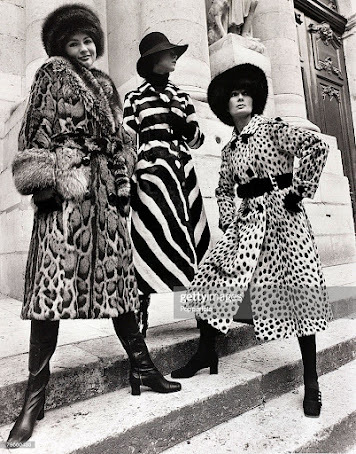 Remember the heyday of fur coats?Reflections: Drag performer RuPaul has famously declared, "We're born naked, and the rest is drag." I think Ed Wood would have agreed heartily with that statement. In the 1971 article "From Birthday Suit to Shrouds," he phrases it just slightly differently: "All of us to a man or woman are born into this world NAKED . . . yet when most of us die we are put to rest in clothes." Eddie might have thought more about clothing than any writer of his generation, male or female, and this article is basically his master's thesis on the topic.
Remember the heyday of fur coats?Reflections: Drag performer RuPaul has famously declared, "We're born naked, and the rest is drag." I think Ed Wood would have agreed heartily with that statement. In the 1971 article "From Birthday Suit to Shrouds," he phrases it just slightly differently: "All of us to a man or woman are born into this world NAKED . . . yet when most of us die we are put to rest in clothes." Eddie might have thought more about clothing than any writer of his generation, male or female, and this article is basically his master's thesis on the topic.A wide-ranging essay about the historical and sexual importance of clothing, "From Birthday Suit to Shrouds" is similar to many of Ed Wood's articles from the early 1970s. Once again, Eddie talks about the "sweater girls" of the 1940s and how the censors of the Hays office tried to ban them from movies so that American servicemen would not be overstimulated. Once again, Ed alludes to fetishists having certain "love objects," often items of clothing such as panties. Once again, Ed talks about how the "true transvestite" is likely to be heterosexual. Once again, he emphasizes how masturbation is integral to transvestism. This one article is like a roll call of his greatest hits.
So what stands out here? What makes "From Birthday Suit to Shrouds" different from the articles around it? Well, for one thing, Eddie somehow manages to incorporate one of his other major obsessions: death. The gloomy tone is set by the article's very title, which is strikingly similar to that of Ed's 1968 book Sex Shrouds and Caskets. Before Eddie even begins to discuss the sexual aspects of clothing—which he eventually does at great length—he goes off on a strange tangent about people being buried in their best clothes and how men used to have only one good suit that they wore on Sundays to church. Did the readers of Flesh & Fantasy want to consider their own mortality while reading a porno mag? If they read this article, they had no choice.
Another factor that distinguishes "From Birthday Suit to Shrouds" is its emphasis on fur fetishism. We're all familiar with Eddie's penchant for angora sweaters, but this time, he talks more about fur coats. He writes: "About the first thing a young girl thinks of once she becomes oriented that she is a girl and she must do things in girlish ways, is about acquiring a fur coat." This may be an odd statement from our modern point of view, since fur coats have long since fallen out of favor, especially among the young. However, I can still remember when these garments were coveted status symbols. For decades, it seemed like every wife on every TV sitcom was goading her husband into buying her a fur coat. Maybe the 1998 Seinfeld episode "The Reverse Peephole" finally killed the fur coat plot for good.
My own mother never owned a fur coat, but I remember other moms in our neighborhood getting them for anniversaries, birthdays, etc. And no Michigander who grew up in the 1970s and '80s can forget those ubiquitous ads for Dittrich Furs out of Detroit. Wonder what Eddie would have thought of them? I'm sure he'd have been utterly transfixed.
One last note, Eddie uses the term "osthresiolagnia" to describe a fetish in which "the odor [of leather or rubber] becomes important to the sex act." This term was unfamiliar to me, but it turns out to be a very real thing . Ed has slightly misspelled it, though. It's osphresiolagnia. Don't say Eddie never taught you anything.
P.S. This is yet another article that I had already reviewed on my blog. I realize now that I got the title slightly wrong when I examined this story back in January 2020 . In his infinite wisdom, Ed Wood chose to pluralize "shrouds" but not "birthday suit." Go figure.
Next: "Problems and the Sex Change" (1972)
Published on January 14, 2022 18:00



